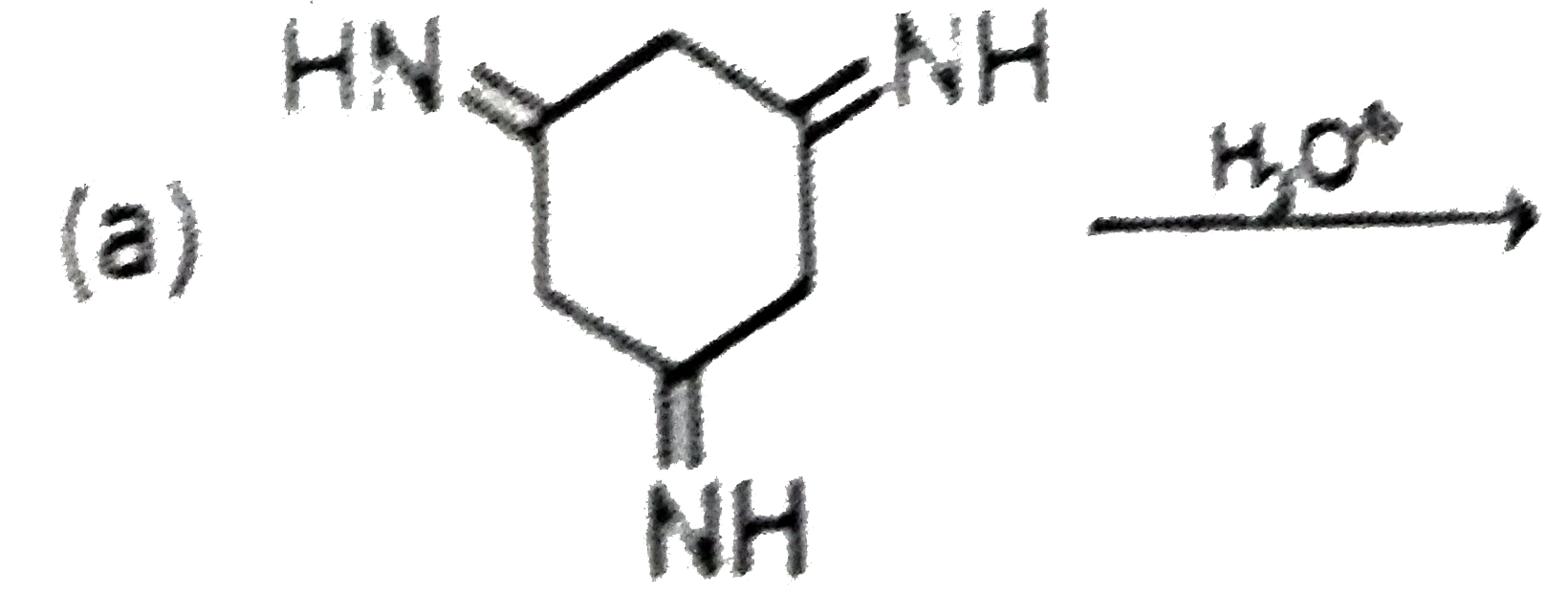Complete the reaction
Ph−CH=CH−CHOPhMgBr−−−−→H3O+ Product
Ph−C∣PhH−C∣OHH−CHO
Ph−C∣PhH=CH2−CHO
Ph−C∣PhH−CH∣Ph−CHO
Ph−C∣PhH−CH2−CH2−OH
The correct Answer is:B
To complete the reaction of Ph−CH=CH−CHO with PhMgBr followed by H3O+, we will follow these steps:
Step 1: Identify the Reactants
We start with the reactant:
- Ph−CH=CH−CHO (which is a phenyl-substituted aldehyde with a double bond).
Step 2: Understand the Grignard Reagent
The Grignard reagent is PhMgBr. In this case, we can represent it as:
- Ph− (the phenyl anion) and MgBr+.
Step 3: Nucleophilic Attack
The phenyl anion (Ph−) acts as a nucleophile and will attack the carbon atom of the aldehyde group (C=O) in Ph−CH=CH−CHO. This is a 1,4-addition reaction:
- The nucleophile attacks the carbon of the carbonyl group, leading to the formation of a new bond.
Step 4: Forming the Intermediate
After the nucleophilic attack, we can represent the intermediate as:
- Ph−CH−CH−CHO− (the carbonyl oxygen now carries a negative charge).
Step 5: Addition of Magnesium Bromide
The magnesium bromide (MgBr+) will coordinate with the negatively charged oxygen:
- The structure now is Ph−CH−CH−CHO−MgBr+.
Step 6: Acid Hydrolysis
Next, we perform acid hydrolysis using H3O+. The negatively charged oxygen will protonate, leading to the formation of an alcohol:
- The intermediate converts to Ph−CH−CH(OH)−CHO.
Step 7: Tautomerization
The product can undergo tautomerization to form an aldehyde:
- The structure rearranges to yield Ph−CH=CH−CHO (the original aldehyde with an additional phenyl group).
Final Product
The final product of the reaction is:
- Ph−CH=CH−CHO (with an additional phenyl group).
Summary of Product
Thus, the final product after the reaction is:
- Ph−CH=CH−CHO (with an aldehyde functional group).
---
We start with the reactant:
- Ph−CH=CH−CHO (which is a phenyl-substituted aldehyde with a double bond).
The Grignard reagent is PhMgBr. In this case, we can represent it as:
- Ph− (the phenyl anion) and MgBr+.
The phenyl anion (Ph−) acts as a nucleophile and will attack the carbon atom of the aldehyde group (C=O) in Ph−CH=CH−CHO. This is a 1,4-addition reaction:
- The nucleophile attacks the carbon of the carbonyl group, leading to the formation of a new bond.
After the nucleophilic attack, we can represent the intermediate as:
- Ph−CH−CH−CHO− (the carbonyl oxygen now carries a negative charge).
The magnesium bromide (MgBr+) will coordinate with the negatively charged oxygen:
- The structure now is Ph−CH−CH−CHO−MgBr+.
Next, we perform acid hydrolysis using H3O+. The negatively charged oxygen will protonate, leading to the formation of an alcohol:
- The intermediate converts to Ph−CH−CH(OH)−CHO.
The product can undergo tautomerization to form an aldehyde:
- The structure rearranges to yield Ph−CH=CH−CHO (the original aldehyde with an additional phenyl group).
The final product of the reaction is:
- Ph−CH=CH−CHO (with an additional phenyl group).
Thus, the final product after the reaction is:
- Ph−CH=CH−CHO (with an aldehyde functional group).
Topper's Solved these Questions
- ALDEHYDES, KETONES AND CARBOXYLIC ACIDS BOOK - AAKASH INSTITUTE ENGLISHCHAPTER - ALDEHYDES, KETONES AND CARBOXYLIC ACIDS EXERCISE - Assignment (SECTION -C Objective type questions more than one options are correct)
11 Videos
- ALDEHYDES, KETONES AND CARBOXYLIC ACIDS BOOK - AAKASH INSTITUTE ENGLISHCHAPTER - ALDEHYDES, KETONES AND CARBOXYLIC ACIDS EXERCISE - Assignment (SECTION -D Linked Comprehension type Questions)
6 Videos
- ALDEHYDES, KETONES AND CARBOXYLIC ACIDS BOOK - AAKASH INSTITUTE ENGLISHCHAPTER - ALDEHYDES, KETONES AND CARBOXYLIC ACIDS EXERCISE - Assignment (Section A Competition Level Questions)
60 Videos
- ALCOHOLS, PHENOLS AND ETHERS BOOK - AAKASH INSTITUTE ENGLISHCHAPTER - ALCOHOLS, PHENOLS AND ETHERS EXERCISE - Try Yourself
5 Videos
- AMINES BOOK - AAKASH INSTITUTE ENGLISHCHAPTER - AMINES EXERCISE - Assignment Section -J (Aakash Challengers Questions)
9 Videos
Similar Questions
Knowledge Check
Ph−CH=N−CH3+Ph−CH2MgClH2O−−→ major product :
APh−O∣∣C−HBPh−CH2−N∣CH2Ph−CH3CPh−CH−CH2∣H3C−NH−PhDNone of theseCompounds (A) and (C ) in the following reactions are
CH3CHO(i)CH3MgBr−−−−−−−−→(ii)H2O(A)H2SO4,Δ−−−−−−→(B)Hydroboration oxidation−−−−−−−−−−−−−−→(C)AidenticalBpositional isomersCfunctional isomersDoptical isomers.
Complete the reaction :
CH3−CH∣CH3−O−CH2−CH3HI−−→
View SolutionComplete the following reactions
CH3CH=CH2mCPBA−−−−→AC2H5MgBr−−−−−−→H3O+B
View SolutionComplete the following reaction CH3−C∣CH3=CH−CH3H2,Ni−−−→?
View SolutionComplete the following reactions
(i) CH3−O∣∣C−CH3CH3MgBr−−−−−→ether(dry)AH3O+−−−→B (ii) CH3−CH2−CH2−CHONi/H2−−−→A
View SolutionComplete the following reaction sequence :
CH3−O∣∣C−CH3(i)CH3MgBr−−−−−−−−→(ii)H2O(A)Na metal−−−−→ether(B)CH3−Br−−−−−→(C)
View SolutionComplete the following reaction sequence :
CH3−O∣∣C−CH3(i)CH3MgBr−−−−−−−−→(ii)H2O(A)Na metal−−−−→ether(B)CH3−Br−−−−−→(C)
View Solution

